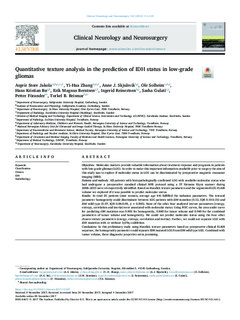| dc.contributor.author | Jakola, Asgeir Store | |
| dc.contributor.author | Zang, YH | |
| dc.contributor.author | Skjulsvik, Anne Jarstein | |
| dc.contributor.author | Solheim, Ole | |
| dc.contributor.author | Bø, Hans Kristian | |
| dc.contributor.author | Berntsen, Erik Magnus | |
| dc.contributor.author | Reinertsen, Ingerid | |
| dc.contributor.author | Gulati, Sasha | |
| dc.contributor.author | Förander, Petter | |
| dc.contributor.author | Brismar, Torkel B. | |
| dc.date.accessioned | 2018-02-20T15:11:58Z | |
| dc.date.available | 2018-02-20T15:11:58Z | |
| dc.date.created | 2017-12-12T10:51:33Z | |
| dc.date.issued | 2017 | |
| dc.identifier.citation | Clinical neurology and neurosurgery (Dutch-Flemish ed. Print). 2017, 164 114-120. | nb_NO |
| dc.identifier.issn | 0303-8467 | |
| dc.identifier.uri | http://hdl.handle.net/11250/2486079 | |
| dc.description.abstract | Objectives
Molecular markers provide valuable information about treatment response and prognosis in patients with low-grade gliomas (LGG). In order to make this important information available prior to surgery the aim of this study was to explore if molecular status in LGG can be discriminated by preoperative magnetic resonance imaging (MRI).
Patients and methods
All patients with histopathologically confirmed LGG with available molecular status who had undergone a preoperative standard clinical MRI protocol using a 3T Siemens Skyra scanner during 2008–2015 were retrospectively identified. Based on Haralick texture parameters and the segmented LGG FLAIR volume we explored if it was possible to predict molecular status.
Results
In total 25 patients (nine women, average age 44) fulfilled the inclusion parameters. The textural parameter homogeneity could discriminate between LGG patients with IDH mutation (0.12, IQR 0.10-0.15) and IDH wild type (0.07, IQR 0.06-0.09, p = 0.005). None of the other four analyzed texture parameters (energy, entropy, correlation and inertia) were associated with molecular status. Using ROC curves, the area under curve for predicting IDH mutation was 0.905 for homogeneity, 0.840 for tumor volume and 0.940 for the combined parameters of tumor volume and homogeneity. We could not predict molecular status using the four other chosen texture parameters (energy, entropy, correlation and inertia). Further, we could not separate LGG with IDH mutation with or without 1p19q codeletion.
Conclusions
In this preliminary study using Haralick texture parameters based on preoperative clinical FLAIR sequence, the homogeneity parameter could separate IDH mutated LGG from IDH wild type LGG. Combined with tumor volume, these diagnostic properties seem promising. | nb_NO |
| dc.language.iso | eng | nb_NO |
| dc.publisher | Elsevier | nb_NO |
| dc.rights | Attribution-NonCommercial-NoDerivatives 4.0 Internasjonal | * |
| dc.rights.uri | http://creativecommons.org/licenses/by-nc-nd/4.0/deed.no | * |
| dc.title | Quantitative texture analysis in the prediction of IDH status in low-grade gliomas | nb_NO |
| dc.type | Journal article | nb_NO |
| dc.type | Peer reviewed | nb_NO |
| dc.description.version | publishedVersion | nb_NO |
| dc.source.pagenumber | 114-120 | nb_NO |
| dc.source.volume | 164 | nb_NO |
| dc.source.journal | Clinical neurology and neurosurgery (Dutch-Flemish ed. Print) | nb_NO |
| dc.identifier.doi | 10.1016/j.clineuro.2017.12.007 | |
| dc.identifier.cristin | 1526123 | |
| dc.description.localcode | © 2017 The Authors. Published by Elsevier B.V. This is an open access article under the CC BY-NC-ND license (http://creativecommons.org/licenses/BY-NC-ND/4.0/). | nb_NO |
| cristin.unitcode | 194,65,15,0 | |
| cristin.unitcode | 194,65,30,0 | |
| cristin.unitcode | 194,65,25,0 | |
| cristin.unitname | Institutt for klinisk og molekylær medisin | |
| cristin.unitname | Institutt for nevromedisin og bevegelsesvitenskap | |
| cristin.unitname | Institutt for sirkulasjon og bildediagnostikk | |
| cristin.ispublished | true | |
| cristin.fulltext | original | |
| cristin.qualitycode | 1 | |

